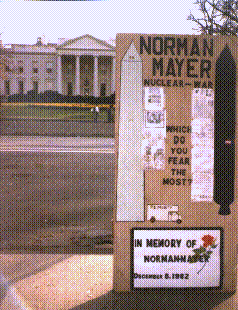The Protest Goes On
 Sympathizers with demonstrator who was slain at White House
Sympathizers with demonstrator who was slain at White House
continue their anti-nuclear vigil
Houston Chronicle March 13, 1983
BY MONA MEGALLI
United Press International
WASHINGTON -- A guard at the gate calls them the regulars. the ones who sit, stand or pace Pennsylvania Avenue nearly every day picketing the White House.
People for or against nuclear war, abortion, the Vietnam War, budget cuts, and many other issues have made the northern front of the White House their
forum.
"Whatever makes the headlines one day, there's someone who comes in the next day to file for a First Amendment permit. It goes in cycles," says National
Park Police spokeswoman Sandra Alley.
Some protest there for a few hours, others persist in their cause for years. Most remain anonymous. Norman Mayer didn't.
On Dec. 8, Mayer, 66, who had demonstrated daily before the White House against nuclear weapons since June 1982, besieged the Washington Monument for
10 hours before he was killed by police.
Coincidentally, nuclear warfare again was the preoccupation of the few regulars who braved a blustery Washington morning One day this month.
Through the White House fence, Concepcion Picciotto threw crumbs to the pigeons on the presidential lawn. She leaned over a large sign that warns of nuclear holocaust in red and green lettering.
Another sign read:"God Bless jelly beans and H-bombs."
Mrs. Picciotto, in a soft Latin accent, spoke of initially coming to Washington to seek justice and freedom.
"I had been on a campaign across the country and couldn't accomplish anything." she said. "I Was here all day and accomplished nothing. Now I am committed to a 24-hour vigil against nuclear weapons. I have been here for 17 months now."
Mayer used to give her a penny for each anti-nuclear pamphlet she handed out for him. Mrs. Picciotto said.
Pressed for details, she suggested that William Thomas, a fellow protester who once was Mayer's protege, could answer more questions. She said he had been on vigil for 19 months.
We walked behind an enormous sign of a mushroom cloud of eerie psychedelic hues. The sign, raised on a mobile platform, slopes to form the side of a shelter, like one-half of a peaked roof.
Thomas, 35. an articulate man with a bushy brown beard and a bad cold, lay on its floor under a quilt. Packed paper bags lined a shelf built into the shelter he has made from bits and planks of discarded wood. Every night, he said, they pack all their signs and roll their shelter farther along the sidewalk to sleep in front of the Old Executive Building.
"All sorts of people have been coming up to talk to me since Norman died," Thomas said."Before, when I started not too many People came. All I had was a
filthy pair of jeans."
His clothes looked clean -- an orange down jacket brown corduroys, and wine leather boots. "Concepcion finds these," he said.
Thomas earnestly launched into a monologue for Mayer, against nuclear Warfare. He went on to explain how, by living "without accommodations." he illustrates humanity's ability to do without the possessions They use atomic warfare to protect.
Another regular, Edward Saffron. 65, bundled in blue against the cold, clear morning, said he has walked his beat for a few hours a week since May 26, 1969. The neat, open-faced man sported a blue and white muffler and a sandwich board calling for world disarmament.
He will only hand out his typed, copyrighted, five-sheet pronouncement on global survival to people who are interested. "I'm not a millionaire. I have to
pay for these," he said.
"After this, I'll go home, eat something, switch on the television and take it easy. I'm here to make the White House know I am here," he said.
"We get a lot of regulars. After a while, unless they are violent, all they do is merge in the past." said J.C. Lindsey, deputy chief of Park Police Office for Operations. As long as protesters cause no trouble "they're our guests," Lindsey said.
Concepcion Information List | Conchita Personal Story
Photographs | The President's Neighbor
 Sympathizers with demonstrator who was slain at White House
Sympathizers with demonstrator who was slain at White House